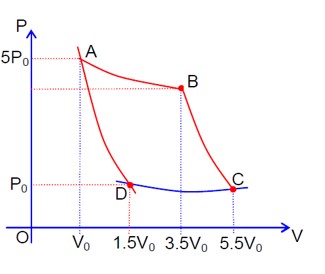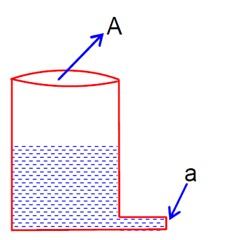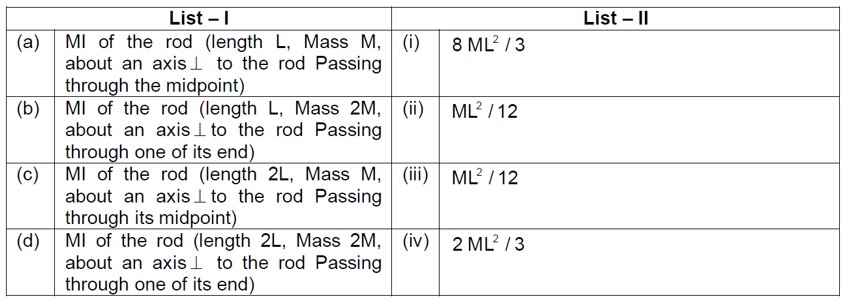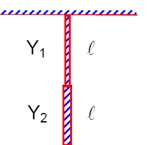Class 11th
Get insights from 8k questions on Class 11th, answered by students, alumni, and experts. You may also ask and answer any question you like about Class 11th
Follow Ask QuestionQuestions
Discussions
Active Users
Followers
New answer posted
3 months agoContributor-Level 10
A→B & D→C (isothermal process)
So, TA = TB & TD = TC. Now B→C & D→A (adiabatic process)
|WBC| = nR/ (γ-1) (TB - TC)
|WAD| = nR/ (γ-1) (TA - TD) = nR/ (γ-1) (TB - TC)
∴ |WBC| = |WAD|
New answer posted
3 months agoContributor-Level 10
1 litre, T = 300K, P = 2 atm, KE = 2*10? J/molecule, no of molecule =?
No. of molecules = (no of moles) * NA = nNA
Also, n = PV/RT = PV/ (NAkT)
KE = (3/2)kT = 2*10? J [Given]
kT = (4/3)*10?
P = 2 atm = 2 * 1.013 * 10? N/m²
vol = 1 lit = 10? ³ m³
No. of molecules = PV/kT = (2*1.013*10? * 10? ³)/ (4/3)*10? ) ≈ 1.5 * 10¹¹
New answer posted
3 months agoContributor-Level 10
Polygon law is applicable in both the situation given but the equation given in the reason is not useful in explaining the assertion.
New answer posted
3 months agoContributor-Level 10
v = √2gh velocity of efflux.
F = v ( dm/dt ) = v (aρv) = aρv² = 2aρgh
fr = µR = µAhρg
For just sliding, for = F
µAhρg = 2aρgh
or µ = 2a/A
New answer posted
3 months agoContributor-Level 10
Let vel of A and B just after collision be VA & VB respectively.
m * 9 + 0 = m * VA + 2mVB
9 = VA + 2VB
again e = (VB - VA)/ (9-0) = 1
9 = VB - VA
From (i) & (ii)
VB = 6 m/s & VA = -3 m/s
Now, for B and C collision (completely inelastic):
2m * 6 + 0 = (2m + 2m)Vc
12m = 4mVc
Vc = 3 m/s
New answer posted
3 months agoContributor-Level 10
I? / I? = (MR²/2) / (mr²/4)
[ M = σπR², m = σπr² ]
= 2 (M/m) (R²/r²)
= 2 (σπR²/σπr²) (R²/r²)
= 2 (R²/r²)² = 2R? /r?
New answer posted
3 months agoContributor-Level 10
(a) I = ML²/12
(b) I = (2M)L²/3
(c) I = M (2L)²/12 = ML²/3
(d) I = (2M) (2L)²/3 = 8ML²/3
New answer posted
3 months agoContributor-Level 9
Y? = (F/A) / (Δl? /l)
Y? = (F/A) / (Δl? /l)
Y = (F/A) / (Δl? + Δl? )/ (2l)
= (F/A) / ( (1/2) * (Δl? /l + Δl? /l) )
= (F/A) / ( (1/2) * (F/ (AY? ) + F/ (AY? ) )
= 2Y? Y? / (Y? + Y? )
New answer posted
3 months agoContributor-Level 10
τ = Iα
I = ½MR² = ½ (10) (0.2)² = 0.2 kgm²
α = (ωf - ωi)/Δt = (0 - 600*2π/60)/10 = -2π rad/s²
τ = |Iα| = 0.2 * 2π = 0.4π = 4π * 10? ¹ Nm
New answer posted
3 months agoContributor-Level 10
W = ∫Fxdy
W = ∫ (5y + 20)dy from 0 to 10
W = [5y²/2 + 20y] from 0 to 10
W = (5 (10)²/2 + 20 (10) - 0 = 250 + 200 = 450 J
Taking an Exam? Selecting a College?
Get authentic answers from experts, students and alumni that you won't find anywhere else
Sign Up on ShikshaOn Shiksha, get access to
- 65k Colleges
- 1.2k Exams
- 679k Reviews
- 1800k Answers





